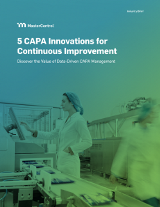
GxP Lifeline
Why Continuous Improvement Starts With Streamlined CAPAs

The need for efficient and verifiable processes to manage corrective action/preventive action (CAPA) is a pressing concern. The U.S. Food and Drug Administration (FDA) reports that since 2018, a “lack of or inadequate CAPA procedures” has consistently been found in 20%-25% of all annual observations. An additional 5%-8% come due to failure to document CAPA management activities.1
The traditional way that quality professionals have tried to handle them is due for optimization. Part of this is due to the complex and subjective nature of quality event management (QEM). It depends heavily on the skills and experience of quality professionals. However, they are limited by fixed processes that dictate their efforts and prevent them from infusing their expertise into QEM activities.
Current Woes With QEM and CAPA Software Applications
Most CAPA software offerings compel quality professionals to adapt their processes to match the software application. On the flip side, the more variable a process is, the less often it is digitized and automated. Quality professionals are prevented from designing and controlling their own processes, which leads to inefficient QEM and negatively impacts continuous improvement efforts. It’s like asking a doctor to perform precision surgery with blunt tools.
Here are a few examples of the limitations of most CAPA management solutions:
- Rigid Processes
- Complexity
- Lack of Visibility
Rigid processes that can’t be easily adapted prevent quality professionals from adequately responding to novel situations. Quality event management activities are dictated by the software application rather than driven by the professional using it. Data capture is often limited.
A software solution that is difficult to use, lacks an intuitive user interface, and/or is disconnected from other quality functions only compounds the complexity of quality event management. No matter how robust a solution is, it won’t be maximized if it is too difficult to use.
Quality personnel who lack visibility into current processes and crucial data points face an uphill battle. They can’t make informed decisions when trying to investigate root causes or develop comprehensive CAPA management plans. Their ability to collaborate with other quality professionals or cross-functional teams is also impaired.
What Does the Quality Professional Bring to Quality Event Management Processes?
Everything. Even with emerging intelligent eQMS solutions, the processes and outcomes that constitute quality event management are driven by quality professionals and must ultimately be governed by them. Quality organizations that are able to map the intelligence of professional talent onto their systems can successfully integrate digital disruption, differentiate themselves from competitors, and consequently reap significant competitive advantages. According to the American Society for Quality (ASQ), “Quality professionals can elevate their role from enforcers to navigators to successfully guide organizations through digital disruption and toward excellence.”2
How Do Advanced Process Capabilities Augment Professional Prowess?
By choosing innovative CAPA management tools, quality leaders can promote innovation across their quality organizations. Iterative process improvements can be made within minutes to help organizations simultaneously respond to acute quality events and incorporate broader quality management objectives into those processes. Being able to change the quality system in a controlled way brings a level of empowerment and accountability to professionals that is essential to foster a true culture of quality.
Here are just a few of the benefits of getting a technological grip on QEM:
- Responsive and Iterative Design
- Optimal Resource Allocation
- Collaboration and Innovation
Processes can be recalibrated over time to meet the evolving needs of a quality organization without requiring the added expense and assistance of IT services.
It is no longer necessary for users to wade through irrelevant processes, forms, and steps to manage quality events. And it is no longer necessary to introduce possible errors and misses as a result.
Configurable process designs allow quality organizations to leverage and scale the ingenuity of professional talent rather than stifle it. The more cross-functional visibility a solution offers into these processes, the more varied perspectives can join to create something truly unique and innovative.
To learn more about optimizing your quality event management processes and resources, download the industry brief, “5 CAPA Innovations for Continuous Improvement.” Implementing a truly innovative QEM solution is easier than you think and well worth it – especially when you can close the gap between quality operations and IT investments with advanced process capabilities.
References:
- "Document to Avoid 483s, Don’t Just Conduct CAPA Investigations, Expert Says,” FDA News, June 21, 2023.
- "Quality 4.0,” American Society for Quality, referenced August 2, 2023.

